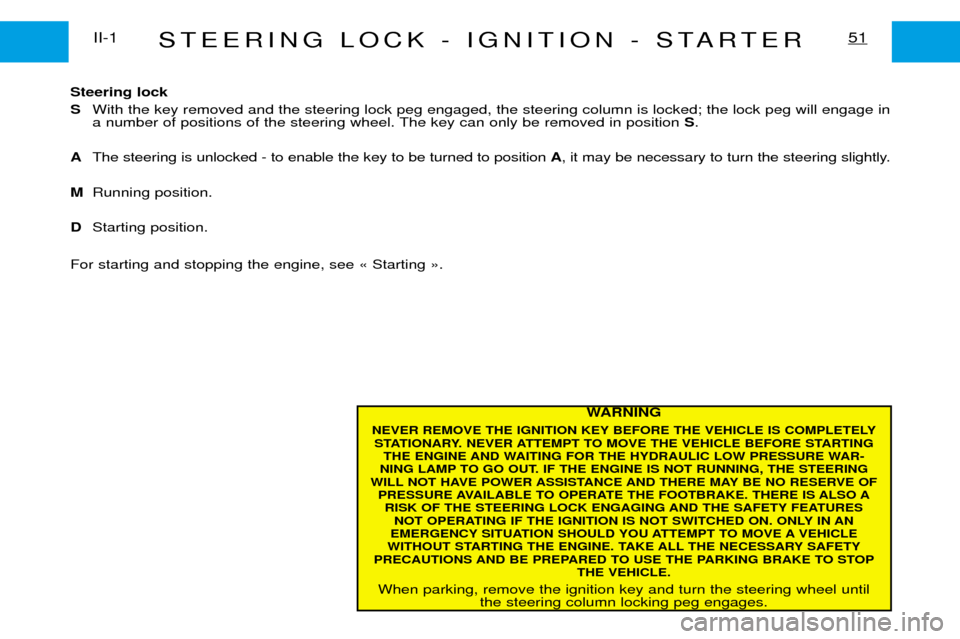Page 55 of 149

CHECKS*77IV-2Beware:When working under the bonnet, the cooling fan could operate if
the engine is hot (even when switched off). The engine oil level should be checked frequently between services (as recommended by the manufacturer), as well as before long journeys.
Priming pump Refer to the section Ç Diesel injection equipment È. Coolant The level should be bet- ween the maximum andminimum marks on the
reservoir. If the engine is hot, wait 15 minutes.Oil quality: see Ç Lubricants and
fluids È. Never work on the cooling sys- tem if the engine is hot. (see
Ç Levels È).
Windscreen, rear screenand headlamp washerfluid It is recommended to use
manufacturer approved products.
12 volt batterySee Ç Emergency starting with a slave battery È. Engine oil Check with the vehicle on level ground, and the
engine off for at least
10 minutes. Level: see Ç Levels È.
Oil quality: see Ç Lubricants and
fluids È.
Take out the oil dipstick.The level must be bet- ween the MAX and MINmarks on the dipstick.
It must not exceed
the maximum mark. Brake fluid The level should be bet- ween the maximum andminimum marks on the
reservoir. Level: see Ç Levels È.
Oil quality: see Ç Lubricants and
fluids È.
If the warning lamp comes on: stop the vehicle
Power steering oilCheck the level with the
engine switched off. Level: see Ç Levels È.
Oil quality: see Ç Lubricants and
fluids È.
Air filterFollow the recommendations in the maintenance guide.
Max Min
* According to model or country
A
B
Page 57 of 149

CHECKS*79IV-2Beware:When working under the bonnet, the cooling fan could operate if
the engine is hot (even when switched off). The engine oil level should be checked frequently between services (as recommended by the manufacturer), as well as before long journeys.
Air filter Follow the recommenda- tions in the maintenanceguide. Coolant The level should be bet- ween the maximum andminimum marks on the
reservoir. If the engine is hot, wait 15 minutes.Oil quality: see Ç Lubricants and
fluids È. Never work on the cooling sys- tem if the engine is hot. (see
Ç Levels È).
Windscreen, rear screenand headlamp washerfluid It is recommended to use
manufacturer approved products.
12 volt batterySee Ç Emergency starting with a slave battery È. Engine oil Check with the vehicle on level ground, and the
engine off for at least
10 minutes. Level: see Ç Levels È.
Oil quality: see Ç Lubricants and
fluids È.
Take out the oil dipstick.The level must be bet- ween the MAX and MINmarks on the dipstick.
It must not exceed
the maximum mark. Brake fluid The level should be bet- ween the maximum andminimum marks on the
reservoir. Level: see Ç Levels È.
Oil quality: see Ç Lubricants and
fluids È.
If the warning lamp comes on: stop the vehicle
Power steering oilCheck the level with the
engine switched off. Level: see Ç Levels È.
Oil quality: see Ç Lubricants and
fluids È.
MaxMin
* According to model or country
B
Page 60 of 149
LEVELSIV-5
82
Beware: When working under the bonnet, the cooling fan could operate if the engi-
ne is hot (even when switched off).
Power steering oil Check the level with the engine
switched off. The level should be between the maximum
and minimum marks on
the reservoir. Never run the engine without oil in the pump reservoir; the pump willbe severely damaged and couldseize. Oil quality: see Ç Lubricants and
fluids È. Engine oilCheck with the vehicle on level
ground, and the engine off for atleast 10 minutes.
Take out the oil dipstick.The level must be between the MAX
and MIN marks on the dips-
tick. Adding engine oil Remove the dipstick before topping up. Check the level after filling.It must not exceed the maximum mark. The oil level should be topped up between services (up to 0.5 l every600 miles). Screw on the cap before shutting the bonnet. Oil quality:
see Ç Lubricants and
fluids È.
Page 64 of 149
STEERING LOCK - IGNITION - STARTERII-1
50
¥ S : Steering lock
To free the steering, turn the steering wheel slightly at the same time as tur- ning the key; avoid using undue force.
¥ A : Accessories
Allows certain electrical accessories to be used. The battery charge warning lamp illuminates.
¥ M : Ignition The following warning lamps should come on: battery charge, handbrake, oil
pressure, engine coolant temperature According to the specific version of
vehicle, the following warning lamps should also come on: Stop, ABS, Engineautodiagnostic, Preheating (Diesel), Front airbag. If one of these lamps fails to light, it could indicate a fault in the system concerned. ¥ D : Starter Release the key as soon as the engine has started. Never operate with the engine running.
These warning lamps are tested with the ignition key in the ignition on position.
Page 65 of 149

STEERING LOCK - IGNITION - STARTER51II-1
WARNING
NEVER REMOVE THE IGNITION KEY BEFORE THE VEHICLE IS COMPLETELY STATIONARY. NEVER ATTEMPT TO MOVE THE VEHICLE BEFORE STARTING THE ENGINE AND WAITING FOR THE HYDRAULIC LOW PRESSURE WAR-
NING LAMP TO GO OUT. IF THE ENGINE IS NOT RUNNING, THE STEERING
WILL NOT HAVE POWER ASSISTANCE AND THERE MAY BE NO RESERVE OF PRESSURE AVAILABLE TO OPERATE THE FOOTBRAKE. THERE IS ALSO ARISK OF THE STEERING LOCK ENGAGING AND THE SAFETY FEATURES NOT OPERATING IF THE IGNITION IS NOT SWITCHED ON. ONLY IN AN
EMERGENCY SITUATION SHOULD YOU ATTEMPT TO MOVE A VEHICLE
WITHOUT STARTING THE ENGINE. TAKE ALL THE NECESSARY SAFETY
PRECAUTIONS AND BE PREPARED TO USE THE PARKING BRAKE TO STOP THE VEHICLE.
When parking, remove the ignition key and turn the steering wheel until the steering column locking peg engages.
Steering lock
S With the key removed and the steering lock peg engaged, the steering column is locked; the lock peg will engage in
a number of positions of the steering wheel. The key can only be removed in position S.
A The steering is unlocked - to enable the key to be turned to position A, it may be necessary to turn the steering slightly.
M Running position.
D Starting position.
For starting and stopping the engine, see Ç Starting È.
Page 68 of 149
BRAKESII-3
54
Handbrake
To create a passage between the front seats, the handbrake lever is mounted
to the left of the driverÕs seat. The handbrake is operated by pulling the lever firmly up - pressing the foot-
brake will reduce the effort required to apply the handbrake. The handbrake is capable of holding the vehicle on all slopes likely to be
encountered but increased effort will be needed on steep slopes.
In all circumstances, as a precautionary measure, engage first gear.On steep slopes, turn the steering towards the kerb.
To release the brake, pull the lever lightly up, press the button on the end of the lever and return the lever to the fully down position. The warning lamp will come on if the handbrake is on or not fully released when the engine is running .
Page 69 of 149

BRAKES55II-4
ABS - Anti-lock Braking System* This system improves vehicle safety by preventing the wheels from locking under emergency braking or when
braking on surfaces offering poor adhesion.
It thus also allows control of the steering to be retained. The operation of the various electronic components of the system is continuously monitored, both before and during your
journey. On switching on the ignition, the ABS lamp will light for approximately two seconds. If it stays on or lights when
driving, the ABS computer has detected a fault and has disconnected the ABS system. If the lamp lights whilst driving, it
again indicates that a fault has been detected and that the ABS system is inactive. In both situations, the normal braking
system is not affected and will continue to function as a conventional braking system without ABS. Nevertheless, to re-
establish the full safety features of the ABS system, It is recommended that the vehicle be examined by a dealer as soonas possible.
On slippery roads (loose stones, snow, ice, etc.), it is imperative to drive with caution.
* According to model or country
Protection fuses under the dashboardF12
(under the bonnet)
MF4 (with ABS)
Page 130 of 149
TOWING - LIFTINGV- 6
110
BEWARE
If the engine is not running,
the steering and braking systems will not be power-assisted.
Towing with the front or rear wheels lifted Use special towing equipment with a rigid bar and straps.Attach the hooks to each of the suspension arms.
Take the necessary precautions to protect the bumper and the front or rear of the vehicle.
NEVER TOW THE VEHICLE WITH THE FRONT OR REAR ENDS LIFTED AND THE WHEELS HANGING FREE. Towing with all wheels on theground
Towing rings are situated at the front and rear of the vehicle.
To prevent the steering from loc- king, the ignition key must be inposition "A". Use a bar with hooks to attach to the rings. Advice In exceptional circumstances, it is permitted to tow the vehicle
at low
speed over a short distance (in
accordance with the local legisla-tion in force). In all other cases, the vehicle must be transported by a trans-
porter.